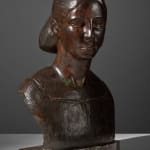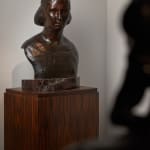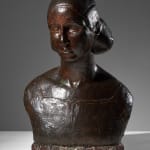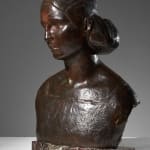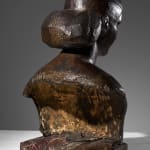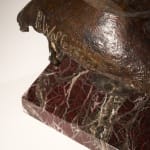Philippe Wolfers
Foundry stamp “cire perdue” Montagutelli Bruxelles
Further images
Philippe Wolfers was (Belgian, 1858 - 1929) a sculptor, silver- and goldsmith, jewellery designer, ivory carver and glassware designer, mainly during the Art Nouveau movement. Philippe Wolfers is generally reckoned among the select group of great Belgian artists who were pioneers and key figures for the Belgian Art Nouveau such as architect Victor Horta (1861-1947); painter, designer and architect Henry van de Velde (1863-1957); architect Paul Hankar (1859-9101); and architect and furniture designer Gustave Serrurier-Bovy (1858-1910).
He studied sculpture under Isidore de Rudder (1855-1943) at the Royal Academy of Fine Arts in Brussels, earning laureate in 1875. He trained as a goldsmith and jewellery designer at the family business and became adept at all aspects of jewellery making. His father, Louis Wolfers (1820-1892), was by then a well-established goldsmith in Brussels and head of the renowned Belgian court jewellers Wolfers Frères. Wolfers was created in 1850 by Louis Wolfers who managed on his own to transform his studio, (which almost exclusively made silverware), within just five years, into one of the main Brussels silver workshops. His children were already prepared for their future career within the company.
In 1885, Louis Wolfers associated himself with his son Philippe. Louis Wolfers Père et Fils became a fact and the studio developed artistically under the impetus of Philippe. Being the protégé of Isidore De Rudder (1855-1943), sculptor, ceramist, engraver and painter, he became the star designer and in charge of the industrial enterprise. Stylistically a Wolfers style was developed. From Japonism and Neo-Rococo, gradually the Art Nouveau style originated.
From around 1897, the Wolfers company and Philippe Wolfers became internationally renowned. The company had an enormous expansion. It opened a new store and new workshops and Wolfers Frères diversified its range of products. The production of Philippe’s jewellery is especially striking. He was even called the "Belgian René Lalique". Their presence at various international exhibitions is far from unnoticed.
Mainly driven by his three sons Philippe, Max and Robert and their cousin Albert Wolfers, the business became around 1900 one of the major European players in the production of silverware and jewellery. The international profile was only possible thanks to a very sophisticated company structure in which each of the family members had been allocated a strict task. Philippe was certainly the most prestigious Wolfers who looked after the artistic direction of the family business, Max explored the market and managed business contracts; Robert mainly concentrated on the improvement of production capacities and Albert was essentially responsible for the general management. Hence one speaks of the 'Wolfers Dynasty'. Although history has mainly remembered Philippe Wolfers name because he was the author of remarkable artistic achievements, he had never been able to achieve his full artistic potential without the corporate structure that made the company run as a well-oiled business machine. It’s obvious that behind the scenes Max, Robert and Albert fulfilled a key role in Philippe’s successful career.
Philippe undertook numerous study trips through Europe, visiting the great world exhibitions in Vienna (1873) and Paris (1889). He was impressed by Japonism: the influence of Japanese culture, art, fashion and aesthetics on Western culture. As a result, from 1882 on, his first designs for silver works and jewellery were influenced by Japanese craftwork and naturalism.
His skills were noticed by the Royal Court and in 1897, he was one of the first Belgian jewellers to use the new medium from Congolese origin, ivory or the so called white gold, at the request of the Belgian King Leopold II who had started in the late 19th century colonial expansion in the around then-largely unexplored Congo Basin. He caused a furore exhibiting these refined objects at the world exhibitions in Antwerp in 1894 and in Tervuren (Brussels) in 1897. Wolfers created e.g. for this famous colonial exhibition the magnificent "Album Congolais". It was a present for the politician Léon de Béthune (1864-1907), who highly contributed behind the scenes to the success of the Tervuren exhibition. It contained 22 original photographs of the exhibition and had a cover that looked like a jewel: made of ivory, silver, gold and bronze decorated with pearls and precious stones.
The success allowed him to open branches of his jewellery business in Antwerp, Liège, Ghent, Düsseldorf, London and Paris.
The years between 1897 and 1905 proved to be the most productive period of his Art Nouveau designs of jewellery and forgeries in gold and silver. Wolfers had artistically and technically been influenced by goldsmith and glassware designer René Lalique (1860-1945), by the Symbolist movement, by flowers, plants and animals (such as dragonflies, crabs, birds), by sensual female forms, by poetic reverence for the woman in her emancipated status of muse. He finished his creations with semi-precious stones, gems, pearls, enamel, ivory and crystal which resulted in luxurious jewellery.
Philippe Wolfers also created precious glassware and became one of the finest glassware designers for the Belgian glass manufacturer Val Saint-Lambert.
In 1905 he started to carve decorative sculptures, freezes and reliefs, executed in precious metals, gemstones and semi-precious stones. In 1907, Philippe stopped his jewellery production and he devoted himself completely to sculpting in marble, ivory and bronze; to ceramics, furniture and metalwork.
In 1909, he commissioned the famous Belgian Art Nouveau architect, Victor Horta (1861-1947), to build his headquarters in Brussels.
In the meantime the company had a turbulent period and the turnover became more important than innovation. After WO I , Philippe Wolfers went looking for that innovation. In the 1920s Wolfers designed in the Art Deco style. His work became more geometrical and abstract. And he made a masterful comeback on the international art scene in 1925 with the participation in the international Arts and Crafts Exhibition in Paris. With his design for the tea and coffee set "Gioconda" (1925) in silver and ivory, he reached an absolute climax.
Gradually his son Marcel Wolfers (1886-1976) also came to the fore. Still very young, he was influenced by his father's commitment to innovation. However, he didn’t join the company immediately as an artistic associate, but as an independent artist and had a career as a sculptor. During the 1920s, he established a reputation as an artist specialised in lacquer work.
In 1928 and 1929 retrospective exhibitions of Philippe Wolfers’ work were organised in Brussels.
The artistic succession of Philippe in 1929, with his sudden death, became a serious problem. The gap was eventually filled by Omer de Waegh (1897-1982). There was a slow evolution of careful innovation towards a classical modernism, which culminated in the table centrepiece "Les Travaux d'Hercule" ("Hercules Works") which was very successful at the World Exhibition in 1937 in Paris. After the presentation of the prestigious "Ondine", which received great attention in the pavilion of the World Exhibition in Brussels in 1958, the downfall of the company started. After 1958 the commercial and the artistic direction of Wolfers came both into the hands of third parties until in 1975 the company ceased to exist.
Museums: his work can be found in major Belgian museums (such as in Antwerp and Brussels), but also internationally, the artist enjoys great recognition in several museums.






